Abstract
The objectives of this study were to understand how different types of barriers to adherence to antiretroviral therapy (ART) were related and their differential impact on objectively measured adherence over time. Data from 151 patients taking ART were used to describe four sub-types of self-reported adherence barriers: medication and health concerns (MHC), stigma (S), family responsibilities (FR), and problems with schedule and routine (PSR). Generalized linear models with generalized estimating equations (GEE) were used to examine the impact of barriers on adherence over time. The sample was 23 % female, mean age 42 years, with 26 % African-American and 20 % Hispanic. The overall average adherence was 73 %. Patients reported at least one PSR barrier in 66 % of study visits, MHC in 40 %, S in 17 %, and FR in 6 %. In 40 % of visits, patients reported two or more barrier sub-types. There were statistically significant (p ≤ 0.05) decreases of 3.9, 2.5, and 2.4 in percent adherence, for MHC, PSR, and S, respectively, per unit increase in barrier score. Interventions to address different types of patient-identified barriers to ART adherence using targeted approaches are needed.


Similar content being viewed by others
References
Bangsberg DR, Perry S, Charlebois ED, et al. Non-adherence to highly active antiretroviral therapy predicts progression to AIDS. AIDS. 2001;15(9):1181–3.
Mills EJ, Nachega JB, Bangsberg DR, et al. Adherence to HAART: a systematic review of developed and developing nation patient-reported barriers and facilitators. PLoS Med. 2006;3(11):e438.
Ammassari A, Trotta MP, Murri R, et al. Correlates and predictors of adherence to highly active antiretroviral therapy: overview of published literature. J Acquir Immune Defic Syndr. 2002;31(Suppl 3):S123–7.
Chesney M. Adherence to HAART regimens. AIDS Patient Care STDS. 2003;17(4):169–77.
Fogarty L, Roter D, Larson S, Burke J, Gillespie J, Levy R. Patient adherence to HIV medication regimens: a review of published and abstract reports. Patient Educ Couns. 2002;46(2):93–108.
Konkle-Parker DJ, Erlen JA, Dubbert PM. Barriers and facilitators to medication adherence in a southern minority population with HIV disease. J Assoc Nurses AIDS Care. 2008;19(2):98–104.
Konkle-Parker D. Medication adherence: what are the barriers and facilitators? HIV Clin. 2007;19(4):8–9.
Roberts KJ. Barriers to and facilitators of HIV-positive patients’ adherence to antiretroviral treatment regimens. AIDS Patient Care STDS. 2000;14(3):155–68.
Roberts KJ, Mann T. Barriers to antiretroviral medication adherence in HIV-infected women. AIDS Care. 2000;12(4):377–86.
Proctor VE, Tesfa A, Tompkins DC. Barriers to adherence to highly active antiretroviral therapy as expressed by people living with HIV/AIDS. AIDS Patient Care STDS. 1999;13(9):535–44.
Murphy DA, Roberts KJ, Martin DJ, Marelich W, Hoffman D. Barriers to antiretroviral adherence among HIV-infected adults. AIDS Patient Care STDS. 2000;14(1):47–58.
Remien RH, Hirky AE, Johnson MO, Weinhardt LS, Whittier D, Le GM. Adherence to medication treatment: a qualitative study of facilitators and barriers among a diverse sample of HIV+ men and women in four US cities. AIDS Behav. 2003;7(1):61–72.
Vervoort SC, Borleffs JC, Hoepelman AI, Grypdonck MH. Adherence in antiretroviral therapy: a review of qualitative studies. AIDS. 2007;21(3):271–81.
Rao D, Kekwaletswe TC, Hosek S, Martinez J, Rodriguez F. Stigma and social barriers to medication adherence with urban youth living with HIV. AIDS Care. 2007;19(1):28–33.
Wilson IB, Laws MB, Safren SA, et al. Provider-focused intervention increases adherence-related dialogue but does not improve antiretroviral therapy adherence in persons with HIV. J Acquir Immune Defic Syndr. 2010;53(3):338–47.
Rogers WH, Wilson IB, Bungay KM, Cynn DJ, Adler DA. Assessing the performance of a new depression screener for primary care (PC-SAD). J Clin Epidemiol. 2002;55(2):164–75.
Genberg BL, Wilson IB, Bangsberg DR, et al. Patterns of antiretroviral therapy adherence and impact on HIV RNA among patients in North America. AIDS. 2012;26(11):1415–23.
Bangsberg DR, Kroetz DL, Deeks SG. Adherence-resistance relationships to combination HIV antiretroviral therapy. Curr HIV/AIDS Rep. 2007;4(2):65–72.
Norton WE, Amico KR, Fisher WA, et al. Information-motivation-behavioral skills barriers associated with intentional versus unintentional ARV non-adherence behavior among HIV + patients in clinical care. AIDS Care. 2010;22(8):979–87.
Vervoort SC, Grypdonck MH, de Grauwe A, Hoepelman AI, Borleffs JC. Adherence to HAART: processes explaining adherence behavior in acceptors and non-acceptors. AIDS Care. 2009;21(4):431–8.
MacDonell K, Naar-King S, Huszti H, Belzer M. Barriers to medication adherence in behaviorally and perinatally infected youth living with HIV. AIDS Behav. 2013;17(1):86–93.
Murphy DA, Sarr M, Durako SJ, et al. Barriers to HAART adherence among human immunodeficiency virus-infected adolescents. Arch Pediatr Adolesc Med. 2003;157(3):249–55.
Simoni JM, Amico KR, Pearson CR, Malow R. Strategies for promoting adherence to antiretroviral therapy: a review of the literature. Curr Infect Dis Rep. 2008;10(6):515–21.
Mbuagbaw L, van der Kop ML, Lester RT et al. Mobile phone text messages for improving adherence to antiretroviral therapy (ART): an individual patient data meta-analysis of randomised trials. BMJ Open 2013;3(12):e003950.
Feldman BJ, Fredericksen RJ, Crane PK, et al. Evaluation of the single-item self-rating adherence scale for use in routine clinical care of people living with HIV. AIDS Behav. 2013;17(1):307–18.
Schackman BR, Dastur Z, Rubin DS, et al. Feasibility of using audio computer-assisted self-interview (ACASI) screening in routine HIV care. AIDS Care. 2009;21(8):992–9.
Gonzalez JS, Batchelder AW, Psaros C, Safren SA. Depression and HIV/AIDS treatment nonadherence: a review and meta-analysis. J Acquir Immune Defic Syndr. 2011;58(2):181–7.
Starace F, Ammassari A, Trotta MP, et al. Depression is a risk factor for suboptimal adherence to highly active antiretroviral therapy. J Acquir Immune Defic Syndr. 2002;31(Suppl 3):S136–9.
Wendel CS, Mohler MJ, Kroesen K, Ampel NM, Gifford AL, Coons SJ. Barriers to use of electronic adherence monitoring in an HIV clinic. Ann Pharmacother. 2001;35(9):1010–5.
Acknowledgments
This work was supported by grants from the National Institute on Drug Abuse (R01DA015679, R21MH073420), the National Institute for Mental Health (R21MH073420; K24MH092242), and the Lifespan/Tufts/Brown Centers for AIDS Research (P30AI042853).
Author information
Authors and Affiliations
Corresponding author
Rights and permissions
About this article
Cite this article
Genberg, B.L., Lee, Y., Rogers, W.H. et al. Four Types of Barriers to Adherence of Antiretroviral Therapy are Associated with Decreased Adherence Over Time. AIDS Behav 19, 85–92 (2015). https://doi.org/10.1007/s10461-014-0775-2
Published:
Issue Date:
DOI: https://doi.org/10.1007/s10461-014-0775-2



